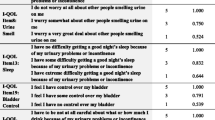Abstract
Purpose: The purpose of this study was to examine the responsiveness of the Overactive Bladder questionnaire (OAB-q) during anti-muscarinic treatment.
Methods: OAB patients were treated with tolterodine ER 4 mg/day for 12 weeks. The OAB-q and 3-day micturition diaries were collected at baseline, 4, and 12 weeks. The patients’ and physicians’ perceptions of treatment benefit were assessed at 4 and 12 weeks. Responsiveness of the OAB-q was examined with effect sizes and comparisons to other measures using ANOVAs, t-tests, and correlations.
Results: A total of 865 patients completed the 12-week study (mean age 61 years; 73% female; 89% Caucasian). From baseline to 4 weeks, significant improvements (p < 0.0001) occurred in all OAB-q subscales, which were maintained through week 12. The OAB-q was highly responsive with subscale effect sizes ranging from 0.44 (social interaction) to 1.2 (symptom bother). Significant score changes in all OAB-q subscales (p < 0.05) were associated with reductions of ≥ë3 urgency episodes, ≥ë3 micturitions, or ≥ë1 incontinence episode per day. Improvements in OAB-q scales were associated with changes in patient and physician perceptions of treatment benefit.
Conclusions: The OAB-q was highly responsive and demonstrated responsiveness to reductions in urinary urgency, frequency, and incontinence during antimuscarinic treatment of OAB. The OAB-q appears to be a useful outcome measure for treatments of OAB.
Similar content being viewed by others
References
P Abrams L Cardozo M Fall et al. (2002) ArticleTitleThe standardisation of terminology of lower urinary tract function: Report from the Standardisation Sub-committee of the International Continence Society. Am J Obstet Gynecol 187 IssueID1 116–126 Occurrence Handle10.1067/mob.2002.125704 Occurrence Handle12114899
I Milsom P Abrams L Cardozo et al. (2001) ArticleTitleHow widespread are the symptoms of an overactive bladder and how are they managed? A population-based prevalence study. BJU Int 87 IssueID9 760–766
WF Stewart JB Rooyen ParticleVan GW Cundiff et al. (2003) ArticleTitlePrevalence and burden of overactive bladder in the United States. World J Urol 20 IssueID6 327–336 Occurrence Handle1:STN:280:DC%2BD3s3osVWkuw%3D%3D Occurrence Handle12811491
K Coyne D Revicki T Hunt et al. (2002) ArticleTitlePsychometric validation of an overactive bladder symptom and health-related quality of life questionnaire: The OAB-q. Qual Life Res 11 IssueID6 563–574 Occurrence Handle10.1023/A:1016370925601 Occurrence Handle1:STN:280:DC%2BD38vkslWjug%3D%3D Occurrence Handle12206577
S Jackson (1997) ArticleTitleThe patient with an overactive bladder–symptoms and quality-of-life issues Urology 50 IssueIDSuppl. 6A 18–22
JN Liberman TL Hunt WF Stewart et al. (2001) ArticleTitleHealth-related quality of life among adults with symptoms of overactive bladder: Results from a U.S. community-based survey. Urology 57 IssueID6 1044–1050
NK Leidy DA Revicki B Geneste (1999) ArticleTitleRecommendations for evaluating the validity of quality of life claims for labeling and promotion. Value in Health 2 IssueID2 113–127
RA Deyo RM Centor (1986) ArticleTitleAssessing the responsiveness of functional scales to clinical change: An analogy to diagnostic test performance. J Chronic Dis 39 IssueID11 897–906
RD Hays D Hadorn (1992) ArticleTitleResponsiveness to change: An aspect of validity, not a separate dimension. Qual Life Res 1 IssueID1 73–75
DA Revicki D Osoba D Fairclough et al. (2000) ArticleTitleRecommendations on health-related quality of life research to support labeling and promotional claims in the United States. Qual Life Res 9 IssueID8 887–900 Occurrence Handle10.1023/A:1008996223999
P Siami LS Seidman D Lama (2002) ArticleTitleA multicenter, prospective, open-label study of tolterodine extended-release 4 mg for overactive bladder: the speed of onset of therapeutic assessment trial (STAT). Clin Ther 24 IssueID4 616–628
J. Cohen (1988) Statistical Power Analysis for the Behavioral Sciences EditionNumber2 Lawrence Erlbaum Associates Hillsdale, NJ
LE Kazis JJ Anderson RF Meenan (1989) ArticleTitleEffect sizes for interpreting changes in health status. Med Care 27 IssueIDSuppl. 3 S178–S189
MA Sprangers CM Moinpour TJ Moynihan et al. (2002) ArticleTitleAssessing meaningful change in quality of life over time: A users’ guide for clinicians. Mayo Clin Proc 77 IssueID6 561–571
G Guyatt S Walter G Norman (1987) ArticleTitleMeasuring change over time: Assessing the usefulness of evaluative instruments. J Chronic Dis 40 IssueID2 171–178
CJ Kelleher PR Reese AM Pleil et al. (2002) ArticleTitleHealth-related quality of life of patients receiving extended-release tolterodine for overactive bladder. Am J Manag Care 8 IssueIDSuppl. 19 S608–S615
Author information
Authors and Affiliations
Corresponding author
Rights and permissions
About this article
Cite this article
Coyne, K.S., Matza, L.S. & Thompson, C.L. The responsiveness of the Overactive Bladder Questionnaire (OAB-q). Qual Life Res 14, 849–855 (2005). https://doi.org/10.1007/s11136-004-0706-1
Accepted:
Issue Date:
DOI: https://doi.org/10.1007/s11136-004-0706-1




